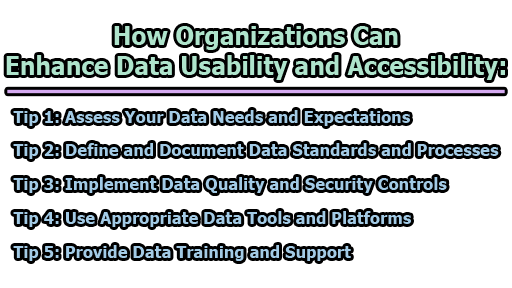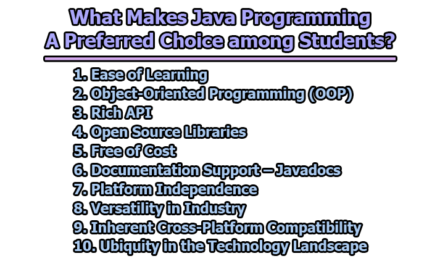How Organizations Can Enhance Data Usability and Accessibility:
Data plays a pivotal role in shaping organizational strategies and decision-making processes. To harness its full potential, it is crucial to prioritize data usability and accessibility. In this article, we will delve into practical tips on how organizations can enhance data usability and accessibility, ensuring that stakeholders can extract maximum value from their data management efforts.
Tip 1: Assess Your Data Needs and Expectations:
Before embarking on efforts to enhance data usability and accessibility, it is imperative to gain a deep understanding of the specific needs and expectations of your stakeholders. This involves conducting a thorough data needs assessment to identify key aspects such as:
1.1 User Demographics and Goals: Determine the various user groups within your organization and understand their specific goals. Whether it’s executives seeking strategic insights, analysts performing detailed data analysis, or operational staff requiring real-time information, recognizing these diverse needs is crucial.
1.2 Challenges and Pain Points: Identify the challenges and pain points experienced by data users. Are there difficulties in accessing certain types of data? Do stakeholders face obstacles in interpreting complex datasets? Understanding these challenges helps in tailoring solutions to address specific pain points.
1.3 Preferences and Workflows: Explore the preferences of different user groups regarding data presentation, visualization, and reporting formats. Additionally, map out the typical workflows involved in data utilization. This step is essential for designing data solutions that seamlessly integrate into existing work processes.
1.4 Quality, Format, and Frequency Requirements: Establish the quality standards your stakeholders expect from the data. Determine the preferred format for data delivery (e.g., raw data, summaries, visualizations) and the frequency at which they require updates. This insight ensures that the data aligns with user expectations and serves its intended purpose effectively.
By undertaking a comprehensive assessment, organizations can pinpoint the specific areas that require improvement and tailor their strategies to address the unique needs of their stakeholders.
Tip 2: Define and Document Data Standards and Processes:
Once the data needs have been identified, the next critical step is to establish clear and comprehensive data standards and processes. This involves:
2.1 Defining Data Standards: Lay out the rules and guidelines that govern the quality, accuracy, and completeness of the data. Standardization ensures consistency, making it easier for users to interpret and trust the data. This includes specifying data naming conventions, formats, and any industry-specific standards that apply.
2.2 Documenting Data Processes: Clearly articulate the steps involved in collecting, storing, transforming, and distributing data. This documentation should encompass end-to-end workflows and detail the responsibilities of different stakeholders at each stage. Well-documented processes ensure transparency, accountability, and adherence to best practices.
2.3 Aligning with Business Objectives: Ensure that the defined standards and processes align with the broader business objectives of the organization. By linking data management practices to strategic goals, organizations can prioritize efforts and resources effectively.
By having well-defined standards and documented processes, organizations create a framework that not only guides current practices but also facilitates future scalability and adaptability.
Tip 3: Implement Data Quality and Security Controls:
Ensuring data reliability and security is paramount for fostering trust among stakeholders. Implementing robust data quality and security controls involves:
3.1 Data Quality Controls: Integrate measures that verify, validate, and enhance the quality of data. This includes conducting regular data audits, implementing validation checks during data entry, and employing algorithms to identify and rectify inconsistencies. By ensuring data accuracy and consistency, organizations provide a solid foundation for decision-making processes.
3.2 Data Security Controls: Implement measures to safeguard data from unauthorized access, modifications, or loss. This involves employing encryption technologies, access controls, and regular security audits. Compliance with relevant regulations and industry standards is crucial to maintaining data integrity and protecting sensitive information.
3.3 Continuous Improvement: Establish a system for continuous monitoring and improvement of data quality and security. Regularly update controls to adapt to emerging threats and challenges, and ensure that data management practices evolve alongside technological advancements.
By actively addressing both data quality and security, organizations fortify their data assets, instilling confidence among stakeholders and supporting a culture of data-driven decision-making.
Tip 4: Use Appropriate Data Tools and Platforms:
The choice of data tools and platforms plays a pivotal role in determining the usability and accessibility of data. To optimize this aspect, organizations should:
4.1 Selecting Data Tools: Identify and implement data tools that align with the specific needs and objectives of the organization. This includes software applications for data analysis, visualization, integration, and reporting. Different user groups may require different tools, so it’s essential to have a diverse toolkit that caters to varied data tasks.
4.2 Choosing Data Platforms: Evaluate and deploy data platforms that serve as the foundation for storing, managing, and providing access to data. Options may include databases, data warehouses, or data lakes. The chosen platform should be scalable to accommodate growing data volumes and compatible with the tools used by stakeholders. Consideration should also be given to data accessibility, ensuring that users can retrieve the information they need efficiently.
4.3 Ensuring Compatibility: Strive for compatibility among data tools and platforms to foster seamless integration and collaboration. A fragmented ecosystem of incompatible tools can hinder data flow and accessibility. Compatibility ensures that data flows seamlessly across the organization, enabling users to leverage the full capabilities of their chosen tools.
4.4 Scalability and Accessibility: Prioritize scalability to accommodate the increasing volume and complexity of data over time. Additionally, ensure that the chosen tools and platforms provide easy and secure access to data. Accessibility ensures that stakeholders can retrieve relevant information promptly, contributing to improved decision-making processes.
By thoughtfully selecting and integrating data tools and platforms, organizations create an environment where data is not only readily available but also efficiently utilized by stakeholders for various purposes.
Tip 5: Provide Data Training and Support:
Empowering stakeholders with the skills and knowledge to interact with data is a crucial step in enhancing usability and accessibility. This involves:
5.1 Data Training Initiatives: Develop and implement data training programs to educate stakeholders on the fundamentals of accessing, understanding, and using data. Tailor these programs to different user groups, considering their roles and responsibilities. Training initiatives should cover topics such as data interpretation, analysis, and visualization, equipping users with the skills necessary for effective data utilization.
5.2 Responsive Data Support: Establish a robust support system to assist stakeholders in overcoming challenges related to data access and usage. This support can be in the form of help desks, online resources, or dedicated personnel. Timely resolution of issues and proactive assistance contribute to a positive user experience, fostering confidence in data-driven decision-making.
5.3 Promoting Data Literacy: Encourage a culture of data literacy within the organization by emphasizing the importance of data-driven decision-making. Foster a learning environment where stakeholders feel empowered to explore and utilize data effectively. This involves ongoing communication, workshops, and initiatives that highlight the value of data in achieving organizational goals.
5.4 Feedback Mechanisms: Implement feedback mechanisms to gather insights from stakeholders regarding the effectiveness of training programs and the usability of data tools. This iterative approach allows organizations to continuously refine their data training and support initiatives based on user feedback.
By investing in comprehensive data training and support, organizations empower their stakeholders to navigate the complexities of data, ensuring that data becomes a valuable asset rather than a challenge to be overcome.
In conclusion, in the era of data-driven decision-making, ensuring data usability and accessibility is non-negotiable. Organizations must assess stakeholder needs, define clear standards, implement quality and security controls, choose appropriate tools and platforms, and invest in training and support. By adopting above strategies, organizations can unlock the full potential of their data, driving innovation, informed decision-making, and overall success.

Library Lecturer at Nurul Amin Degree College










